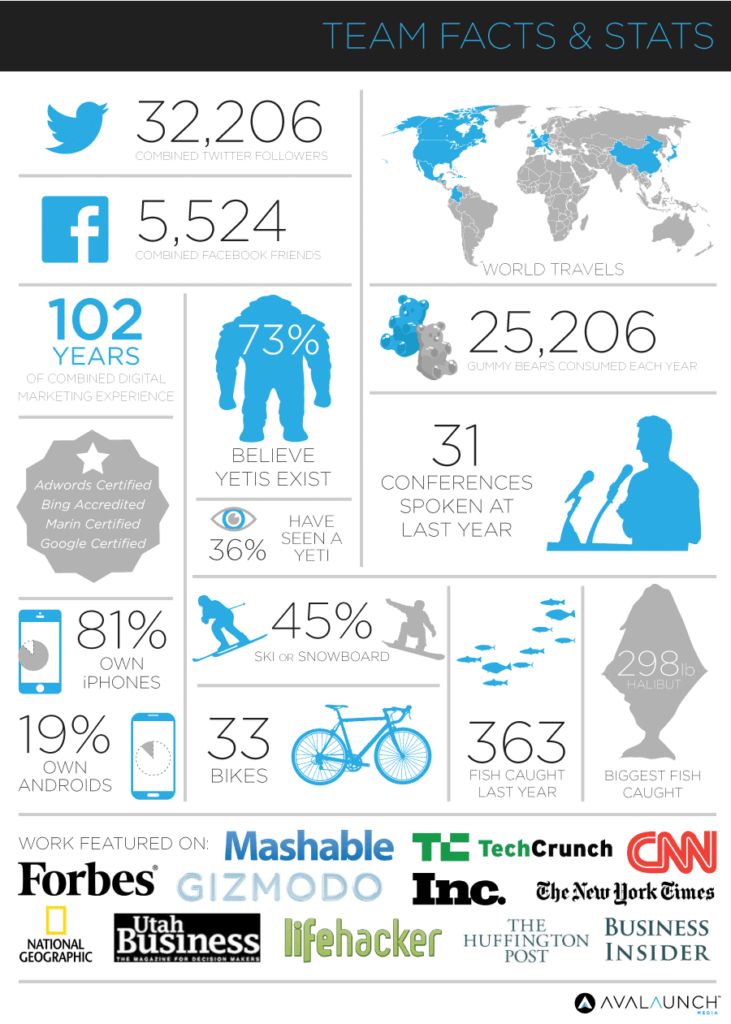Dane Dickerson is an SEO Lead delivering results for enterprise clients at Avalaunch Media. He tries to be good at Twitter at @deighne. Buy him a bahn mi.

 Instead, I like to think about how Google can evaluate E-A-T metrics with the data we already know they monitor. If I was a search engine, I’d look at metrics like referral traffic sources, brand clicks, and engagement with “trust” pages on site; about us, our story, or meet our team pages.
Instead, I like to think about how Google can evaluate E-A-T metrics with the data we already know they monitor. If I was a search engine, I’d look at metrics like referral traffic sources, brand clicks, and engagement with “trust” pages on site; about us, our story, or meet our team pages.
 (The CoSchedule Blog gave us a mention in their piece on what they think about E-A-T Content — check it out later.)
Does every about us page need an infographic? Probably not. Motion graphics work in a lot of situations where an audience with time and curiosity is expected, and some pages need SEO-minded writing more than anything else. Remember that the medium is part of the message, but the lack of a message can’t be made up for with a beautiful medium.
But if you want to build real expertise, authority, and trust with users, don’t leave them hanging with your content. Prove your value, show your stripes, and users just might see them.
(The CoSchedule Blog gave us a mention in their piece on what they think about E-A-T Content — check it out later.)
Does every about us page need an infographic? Probably not. Motion graphics work in a lot of situations where an audience with time and curiosity is expected, and some pages need SEO-minded writing more than anything else. Remember that the medium is part of the message, but the lack of a message can’t be made up for with a beautiful medium.
But if you want to build real expertise, authority, and trust with users, don’t leave them hanging with your content. Prove your value, show your stripes, and users just might see them.

Feed Me, Seymour
Google’s Expertise, Authoritativeness and Trust (E-A-T) search quality guidelines, officially introduced this year, are among the top three considerations for Page Quality. E.A.T. is a big update, but I’m skeptical of a lot of the discussion surrounding it. Not because an update didn’t happen (it did), or because “expertise, authoritativeness, and trust” are bad (they’re not), but because a lot of the discussion centers on tactics that aren’t measurable by Google. We’re talking BBB listings, social media content, I even heard someone in my network talk about the Chamber of Commerce. Instead, I like to think about how Google can evaluate E-A-T metrics with the data we already know they monitor. If I was a search engine, I’d look at metrics like referral traffic sources, brand clicks, and engagement with “trust” pages on site; about us, our story, or meet our team pages.
Instead, I like to think about how Google can evaluate E-A-T metrics with the data we already know they monitor. If I was a search engine, I’d look at metrics like referral traffic sources, brand clicks, and engagement with “trust” pages on site; about us, our story, or meet our team pages.
What /about.php Bob?
Are you hiding something? Maybe I’m more skeptical than a lot of web users, but that’s usually my first question when I land on a new site. If you don’t have a clear path toward telling users who you are and where you came from, you’ve already lost any audience with a modicum of skepticism. The key to this audience is superseding expectations — going above and beyond what they looked for, by inducing ease. Daniel Kahneman talks about this is in Thinking Fast and Slow; to paraphrase, when your questions are met with clear answers, it stops the kind of critical cognition that provokes distrust, and instead sets you into ‘cognitive ease’ — magically, everything is easy, everything is clear, and a feeling of trust pervades over inquiries. That’s what Avalaunch Media has strived to do on our about us page — we took the expectation for content (so often on agency websites this is merely fluff about a marketing company known for design) and make it a “show, don’t tell” moment for users. (The CoSchedule Blog gave us a mention in their piece on what they think about E-A-T Content — check it out later.)
Does every about us page need an infographic? Probably not. Motion graphics work in a lot of situations where an audience with time and curiosity is expected, and some pages need SEO-minded writing more than anything else. Remember that the medium is part of the message, but the lack of a message can’t be made up for with a beautiful medium.
But if you want to build real expertise, authority, and trust with users, don’t leave them hanging with your content. Prove your value, show your stripes, and users just might see them.
(The CoSchedule Blog gave us a mention in their piece on what they think about E-A-T Content — check it out later.)
Does every about us page need an infographic? Probably not. Motion graphics work in a lot of situations where an audience with time and curiosity is expected, and some pages need SEO-minded writing more than anything else. Remember that the medium is part of the message, but the lack of a message can’t be made up for with a beautiful medium.
But if you want to build real expertise, authority, and trust with users, don’t leave them hanging with your content. Prove your value, show your stripes, and users just might see them.
